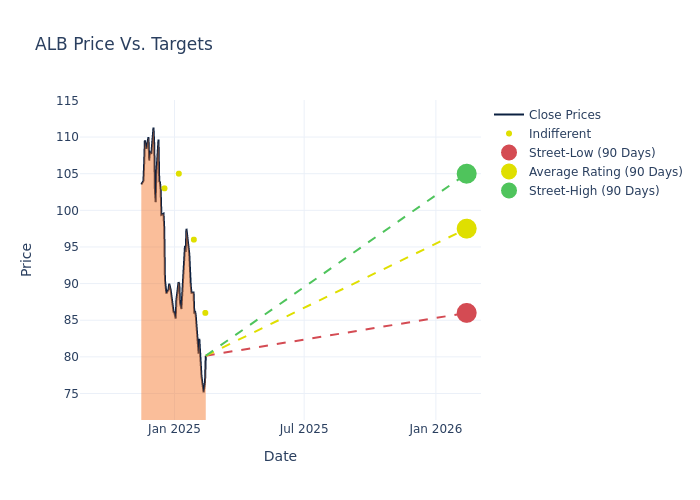Throughout the last three months, 4 analysts have evaluated Albemarle ALB, offering a diverse set of opinions from bullish to bearish.
The table below offers a condensed view of their recent ratings, showcasing the changing sentiments over the past 30 days and comparing them to the preceding months.
| Bullish | Somewhat Bullish | Indifferent | Somewhat Bearish | Bearish | |
|---|---|---|---|---|---|
| Total Ratings | 0 | 0 | 4 | 0 | 0 |
| Last 30D | 0 | 0 | 1 | 0 | 0 |
| 1M Ago | 0 | 0 | 1 | 0 | 0 |
| 2M Ago | 0 | 0 | 2 | 0 | 0 |
| 3M Ago | 0 | 0 | 0 | 0 | 0 |
Analysts' evaluations of 12-month price targets offer additional insights, showcasing an average target of $97.5, with a high estimate of $105.00 and a low estimate of $86.00. This upward trend is evident, with the current average reflecting a 1.56% increase from the previous average price target of $96.00.

Decoding Analyst Ratings: A Detailed Look
The analysis of recent analyst actions sheds light on the perception of Albemarle by financial experts. The following summary presents key analysts, their recent evaluations, and adjustments to ratings and price targets.
| Analyst | Analyst Firm | Action Taken | Rating | Current Price Target | Prior Price Target |
|---|---|---|---|---|---|
| Joshua Spector | UBS | Lowers | Neutral | $86.00 | $99.00 |
| Peter Osterland | Truist Securities | Announces | Hold | $96.00 | - |
| John Roberts | Mizuho | Lowers | Neutral | $105.00 | $110.00 |
| Ben Kallo | Baird | Raises | Neutral | $103.00 | $79.00 |
Key Insights:
- Action Taken: Responding to changing market dynamics and company performance, analysts update their recommendations. Whether they 'Maintain', 'Raise', or 'Lower' their stance, it signifies their response to recent developments related to Albemarle. This offers insight into analysts' perspectives on the current state of the company.
- Rating: Analysts unravel qualitative evaluations for stocks, ranging from 'Outperform' to 'Underperform'. These ratings offer insights into expectations for the relative performance of Albemarle compared to the broader market.
- Price Targets: Analysts navigate through adjustments in price targets, providing estimates for Albemarle's future value. Comparing current and prior targets offers insights into analysts' evolving expectations.
To gain a panoramic view of Albemarle's market performance, explore these analyst evaluations alongside essential financial indicators. Stay informed and make judicious decisions using our Ratings Table.
Stay up to date on Albemarle analyst ratings.
Get to Know Albemarle Better
Albemarle is one of the world's largest lithium producers. In the lithium industry, the majority of demand comes from batteries, where lithium is used as the energy storage material, particularly in electric vehicles. Albemarle is a fully integrated lithium producer. Its upstream resources include salt brine deposits in Chile and the US and two hard rock mines in Australia, both of which are joint ventures. The company operates lithium refining plants in Chile, the US, Australia, and China. Albemarle is a global leader in the production of bromine, used in flame retardants. It is also a major producer of oil refining catalysts.
Albemarle: Delving into Financials
Market Capitalization Analysis: Below industry benchmarks, the company's market capitalization reflects a smaller scale relative to peers. This could be attributed to factors such as growth expectations or operational capacity.
Revenue Challenges: Albemarle's revenue growth over 3 months faced difficulties. As of 30 September, 2024, the company experienced a decline of approximately -41.37%. This indicates a decrease in top-line earnings. In comparison to its industry peers, the company trails behind with a growth rate lower than the average among peers in the Materials sector.
Net Margin: Albemarle's net margin is below industry standards, pointing towards difficulties in achieving strong profitability. With a net margin of -81.99%, the company may encounter challenges in effective cost control.
Return on Equity (ROE): The company's ROE is below industry benchmarks, signaling potential difficulties in efficiently using equity capital. With an ROE of -13.07%, the company may need to address challenges in generating satisfactory returns for shareholders.
Return on Assets (ROA): Albemarle's ROA falls below industry averages, indicating challenges in efficiently utilizing assets. With an ROA of -6.2%, the company may face hurdles in generating optimal returns from its assets.
Debt Management: Albemarle's debt-to-equity ratio is below the industry average at 0.45, reflecting a lower dependency on debt financing and a more conservative financial approach.
The Core of Analyst Ratings: What Every Investor Should Know
Experts in banking and financial systems, analysts specialize in reporting for specific stocks or defined sectors. Their comprehensive research involves attending company conference calls and meetings, analyzing financial statements, and engaging with insiders to generate what are known as analyst ratings for stocks. Typically, analysts assess and rate each stock once per quarter.
Analysts may enhance their evaluations by incorporating forecasts for metrics like growth estimates, earnings, and revenue, delivering additional guidance to investors. It is vital to acknowledge that, although experts in stocks and sectors, analysts are human and express their opinions when providing insights.
Which Stocks Are Analysts Recommending Now?
Benzinga Edge gives you instant access to all major analyst upgrades, downgrades, and price targets. Sort by accuracy, upside potential, and more. Click here to stay ahead of the market.
This article was generated by Benzinga's automated content engine and reviewed by an editor.
Edge Rankings
Price Trend
© 2025 Benzinga.com. Benzinga does not provide investment advice. All rights reserved.
date | ticker | name | Price Target | Upside/Downside | Recommendation | Firm |
|---|
Trade confidently with insights and alerts from analyst ratings, free reports and breaking news that affects the stocks you care about.